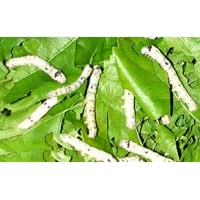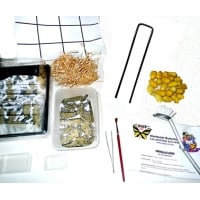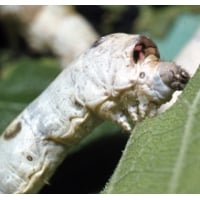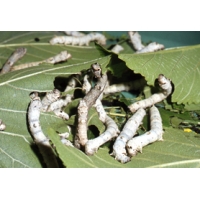SILKWORM EGGS and Silkworms
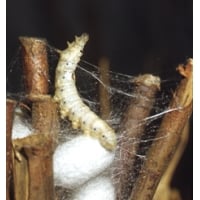
SILKWORM EGGS - INTRODUCTION
The best rearing season is May to October. Eggs supplied from October onwards are for hatching in the following year. In winter orders will be booked for supply in the spring. Eggs ordered in August/September are right at the end of their hatching season. Expect a lower hatch rate from end of season eggs.
Although there are reports of using other foodplants, the only satisfactory leaf food for silkworms is Mulberry. This is sometimes found in the gardens of large houses and old parsonages. Mulberry trees are available from larger nurseries. Any Morus species is suitable: White, Black or any other Mulberry. The larvae eat a lot, so make sure you have a good supply of leaves.
If you don't have Mulberry leaves you can rear Silkworms on artificial diet. See diet listed in this section and order with your Silkworm eggs if you want to solve the problem of finding foodplant for the Silkworms.
Keep the eggs refrigerated until the Mulberry buds open. In 4-6 weeks the larvae are spinning their cocoons.
Instructions are not sent with the eggs but they are given below. The instructions are copyright but can be copied and printed out for your personal use.
Worldwide Butterflies & Lullingstone Silk Farm
PREPARING MULBERRY DIET from Powder
Small packet of powder for 20 Silkworms needs 400ml hot tap water.
Mix thoroughly using a cooking mixer until all traces of powder are absorbed. The final consistency should be a paste, not liquid and not a stiff paste.
-
Pour into a lidded microwave container. The liquid should be to a depth of 15 to 20mm. Set the lid aside until step 6.
-
Cover the container with cling film. Pierce the film with a needle in about 10 places.
-
Microwave for 8-10 minutes with 800-850 Watt oven, or proportionately less for a higher wattage oven.
-
Remove the container from oven: press the cling film down so that it is in contact with the surface of the diet. This reduces the formation of moisture and helps to keep the diet sterile.
-
Allow to cool. Put the lid on the container, then store airtight in a fridge ready for use. It will keep for a month or two.
NOTE. Dried powder can be stored for about a year in the fridge. To avoid contamination, please avoid handling either dry powder or cooked diet any more than is necessary. If you do touch the diet, use sterile latex gloves, clean forceps or well-washed and dried hands.
SILKWORM REARING
Silkworms will change from artificial diet to Mulberry leaf, but don't try to change from leaf to diet.
Eggs can be incubated if you are ready immediately, otherwise place them in a refrigerator (not deep freeze), in the smallest size plastic box. The ideal temperature is 3° - 5°C.
SILKWORM REARING on artificial diet
Although Silkworms are normally reared on Mulberry leaves they can be reared at sny time of the year, feeding on artificial diet, as long as they are kept warm enough. Silkworms are kept in small plastic boxes for their early life. Later they are kept in open trays. They do not do well in cages, as other caterpillars do, neither can they be kept out of doors. The Mulberry Silkmoth no longer exists in the wild: it originated in China and may even be derived from one of the wild Bombyx (or Theophila) species, but certainly its habits have been changed by thousands of years of domestication and we think its appearance may also have changed from camouflaged shades of brown, to white and cream colours
Method
Incubation should be carried out when you have a good supply of Mulberry leaf or artificial diet available. For leaves this is normally between May and October. If you are ging to use artificial diet, you can rear silkworms at any time of year, as long as you can keep them at the proper temperature.
Eggs require about 2-3 months cold temperature (3 - 8°C) to simulate winter, before they will hatch. Take the box of eggs out of refrigeration and hold it at room temperature (15 - 20°C) for one or two days. Then put in a place, such as an airing cupboard at 25-28oC (check this temperature first for a few hours, using a thermometer). Place a small blob of damp cotton wool or tissue in the box with the eggs. Do not stand the box on a direct source of heat (such as a radiator) and ensure that the temperature is even underneath and all round the box of eggs. Do not place in sunlight. Each day wipe out any condensation, but renew the moisture in the cotton wool or tissue. Incubation usually takes from 8 to 14 days.
When the young silkworms hatch, they must be left with their egg shells, for 2-4 hours, because their first meal is taken by eating the empty shell.
Have prepared the smaller plastic rearing box, lined with tissue in the base and with a small portion of food,
Gently coax the larvae on to the bristles of the paintbrush, one by one, and transfer them on to a neat slice of prepared diet, finally replacing the lids of both the egg box and the larvae box. Both should be kept at 25-28°C.
First week of care
Let the silkworms cluster. Each day wipe away any condensation and rescue any stragglers. For a number of days the silkworms just need inspection, and the removal of any unwanted condensation. When too much waste material builds up you can either remove it and replenish with fresh diet, or prepare a new piece of diet in another box, and gently transfer the larvae. Silkworms are best not handled more than is necessary, especially when they are resting to change skin, so you can settle on which method you find works best for you.
As the silkworms grow
At approximately weekly intervals, silkworms change their skins. The first signs of this come when they stop feeding and rest with their heads raised. You can see that the head capsule looks rather pushed forward and is small in comparison with the swelling behind, which is the new head. After several days, the old head capsule drops off, the skin splits, and is shrugged off the tail end. Quickly the new skin dries and the silkworm then has an increased appetite. It is always best to tend silkworms with the least possible handling, but it is especially important not to disturb them when they are resting on their pads of silk to skin change.
The rate of growth of silkworms depends upon temperature. At room temperature (say 15°C) growth may be slow. A temperature of about 23°C is better. Do not stand on a direct source of heat (such as a radiator) and never stand silkworms in sunlight. From hatching to cocooning the life of a silkworm is about 5-6 weeks, but longer in lower temperatures.
The time to change to a larger rearing container comes when silkworms are looking crowded or the cluster of silkworms has enlarged so much that they are close to the sides of the box. A lid is not necessary after about 2 weeks. Unlike other caterpillars, silkworms do not stray very far.
Humidity: In the first 4 days after hatching, it is a good idea to keep a small piece of wet cotton wool or tissue in a corner of the box. This keeps the food moist and fresher between feeds. After this period, if a lid is on the box, there is a danger of the litter and droppings producing mould, so remove the moist pad. Silkworms like moderate humidity. Excess condensation should be wiped out.
After the fourth skin change, the appetite of silkworms increases dramatically. In this last week before cocoon spinning, silkworms may consume something like ten times the amount of food provided in all the time between hatching and this point.
Disease
Hopefully this will not occur but silkworms are very prone to disease, especially if starved or kept in anything less than totally hygienic conditions. If a sick or dead individual is found, remove it immediately, using an instrument, spoon or tissue rather than fingers. Remove the portion of food or lining paper that surrounded the suspected victim. Disinfect any instrument used and wash hands thoroughly. Disease may be caused by virus or bacteria (or both). It is seldom possible to cure and is always best prevented. Temporary starvation or poor conditions can cause death much later in life.
Cocoon Spinning
Larvae that are ready to spin become slightly translucent, often tinged with pale yellow. They do stray at this time and tend to climb upwards. They look for a place where they can spin an Anchorage for the cocoon. In nature they would choose a network of twigs, a v-shaped branch or a hollow in the wood.
One method in captivity is to surround the inner wall of the rearing tray with wood wool, hay, straw or heather twigs. The silkworms will make their way into this material as soon as they are ready. You can also pick out each silkworm when it is ready to spin, and place it in a paper cone. Before spinning, the silkworm ejects a fluid blob - this should not be confused with signs of disease. The anchorage threads are formed in less than half a day. Soon you see the feint
shape of a cocoon. Eventually the cocoon becomes thicker and you no longer see the caterpillar inside, but the spinning continues for three days. The change inside from larva to pupa necessitates leaving them undisturbed for 7-10 days because the skin of the fresh pupa is extremely tender and vulnerable. You will probably wish to breed from your cocoons, so leave them in the wood wool and the moths will emerge in 3 to 4 weeks.
In future, if you are rearing a greater number and wish to reel some cocoons, you must not let the moths emerge as they make a hole and break the silk. To stop them emerging, place the cocoons in a deep freeze for 24 hours. Then keep them in a dry place (not in a plastic bag or they will go mouldy) until you are ready to reel them.
Egg laying
Silkmoths emerge in the early morning. They mate very readily and stay together, sometimes for hours, sometimes for days. Females are less active than males, they have a fatter abdomen and rest with their tail segments extended, emitting a pheromone to attract males. If you have only a few moths, they can be put on a sheet of paper in a tray. The females will lay eggs at random on the paper. With larger numbers you can control the egg-laying by enclosing the paired moths in a paper laying cone. Although the moths often come out of their cones, they will usually lay eggs in a neat circle within the confines of the cone. Eggs are yellow when laid. Fertile eggs turn grey. They will not normally produce larvae until the following season. Keep them for 2-3 months in open trays at room temperature, before refrigerating them for the winter.
Silkworms Bombyx mori 50 Medium Silkworms
For delivery only to GB addresses as they don't travel long distances well.
Nearer half-grown these are advanced and, according to temperature, will be mature in a couple of weeks. Suitable size for class demonstration.
THE MINI SILK FARM
A complete outfit for rearing silkworms from egg to cocoon, and reeling your own raw silk. Everything is provided: a small batch of eggs, food for the entire life of 20 silkworms, all the rearing equipment, detailed educational documentation and instructions, and a simple reeling device.
There is even a small bag of cocoons so that you can practise reeling, and don't have to wait to rear the cocoons from the egg.

Normally Silkworms feed on Mulberry leaves. This is an uncommon tree that is not always readily available, so we are providing a substitute food, which is a powder that comes with the necessary instructions for preparing the artificial diet in the kitchen. You will have a supply of fresh food always available for the silkworms throughout their life of about a month.
The Mini Silk Farm can be bought at any time of the year. The eggs are stored in a fridge until incubation. Although rearing in summer is easier because of temperature, you can rear silkworms almost throughout the year, if you can keep them at about 25º-28ºC. Eggs supplied in winter will need to be refrigerated for 8-12 weeks before incubation.
The instructions guide you through easy rearing, preparation of the artificial diet and the reeling process. The Mini Silk Farm is fun and unusually educational.
Artificial Mulberry Diet powder for 20 Silkworms
Until now it has not been possible to rear silkworms without their natural foodplant Mulberry. Mulberry is often difficult to find but we are now able to offer a very convenient artificial diet that can be used as a substitute food, in any part of the world and at almost any time of the year, providing you can keep the silkworms at 25-28 degrees C. Eggs supplied in November/December will need to be refrigerated for 8-12 weeks before incubation.
The diet is sent as a sachet of powder that is easily prepared in the kitchen. It comes packeted to give sufficient food for the entire life of the silkworms, enough for 20 Silkworms. The powder can be kept for a year or more in a fridge. Made up diet can be refrigerated and kept for a month or more. Silkworms fed on diet will usually change to leaf if required, but if fed at first on leaf, they will not usually take to the diet. The life of a silkworm kept at the required temperature is about 5 weeks.
Artificial diet takes a lot less time and trouble than rearing on leaf. More importantly this enables rearing when Mulberry cannot be obtained. Eggs supplied in November - January will need to be refrigerated for 8-12 weeks before incubation. Rearing Silkworms is very educational and suitable for schools and families.
SILKWORM EGGS Bombyx mori WHITE COCOONS
White larvae, producing attractive pure white cocoons. Silkworms require Mulberry leaf, or artificial diet.
Instructions are not sent with the eggs but they are given at the head of the Silk section. Click on silk near the bottom of the Main Menu (top left of the screen)
In winter orders will be booked for supply in the spring. The best rearing season is May to October. Eggs supplied from October onwards are for hatching in the following year. Although there are reports of using other foodplants, the only satisfactory food plant for silkworms is Mulberry. This is sometimes found in the gardens of large houses and old parsonages. Mulberry trees are available from larger nurseries. Any Morus species is suitable: White, Black or any other Mulberry. The larvae eat a lot, so make sure you have a good supply of leaves.
NOW YOU CAN REAR SILKWORMS EVEN IF YOU HAVE NO MULBERRY! There are sachets of artificial diet that you make up in the kitchen. Each sachet is the amount needed to rear 20 silkworms throughout their life.
SILKWORM EGGS Bombyx mori WHITE COCOONS
White larvae, producing attractive pure white cocoons. Silkworms require Mulberry leaf, or artificial diet.
Instructions are not sent with the eggs but they are given at the head of the Silk section. Click on silk near the bottom of the Main Menu (top left of the screen)
In winter orders will be booked for supply in the spring. The best rearing season is May to October. Eggs supplied from October onwards are for hatching in the following year. Although there are reports of using other foodplants, the only satisfactory food plant for silkworms is Mulberry. This is sometimes found in the gardens of large houses and old parsonages. Mulberry trees are available from larger nurseries. Any Morus species is suitable: White, Black or any other Mulberry. The larvae eat a lot, so make sure you have a good supply of leaves.
NOW YOU CAN REAR SILKWORMS EVEN IF YOU HAVE NO MULBERRY! There are sachets of artificial diet that you make up in the kitchen. Each sachet is the amount needed to rear 20 silkworms throughout their life.
SILKWORM EGGS Bombyx mori WHITE COCOONS
White larvae, producing attractive pure white cocoons. Silkworms require Mulberry leaf, or artificial diet.
Instructions are not sent with the eggs but they are given at the head of the Silk section. Click on silk near the bottom of the Main Menu (top left of the screen)
In winter orders will be booked for supply in the spring. The best rearing season is May to October. Eggs supplied from October onwards are for hatching in the following year. Although there are reports of using other foodplants, the only satisfactory food plant for silkworms is Mulberry. This is sometimes found in the gardens of large houses and old parsonages. Mulberry trees are available from larger nurseries. Any Morus species is suitable: White, Black or any other Mulberry. The larvae eat a lot, so make sure you have a good supply of leaves.
NOW YOU CAN REAR SILKWORMS EVEN IF YOU HAVE NO MULBERRY! There are sachets of artificial diet that you make up in the kitchen. Each sachet is the amount needed to rear 20 silkworms throughout their life.

